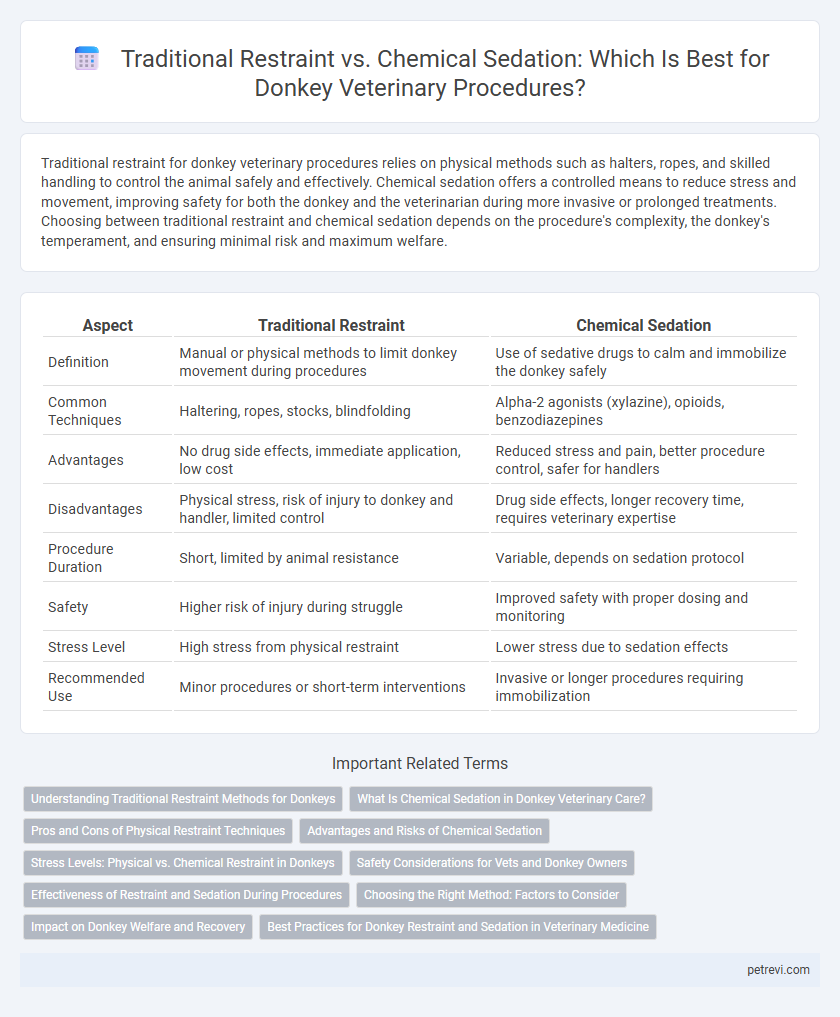Traditional restraint for donkey veterinary procedures relies on physical methods such as halters, ropes, and skilled handling to control the animal safely and effectively. Chemical sedation offers a controlled means to reduce stress and movement, improving safety for both the donkey and the veterinarian during more invasive or prolonged treatments. Choosing between traditional restraint and chemical sedation depends on the procedure's complexity, the donkey's temperament, and ensuring minimal risk and maximum welfare.
Table of Comparison
| Aspect | Traditional Restraint | Chemical Sedation |
|---|---|---|
| Definition | Manual or physical methods to limit donkey movement during procedures | Use of sedative drugs to calm and immobilize the donkey safely |
| Common Techniques | Haltering, ropes, stocks, blindfolding | Alpha-2 agonists (xylazine), opioids, benzodiazepines |
| Advantages | No drug side effects, immediate application, low cost | Reduced stress and pain, better procedure control, safer for handlers |
| Disadvantages | Physical stress, risk of injury to donkey and handler, limited control | Drug side effects, longer recovery time, requires veterinary expertise |
| Procedure Duration | Short, limited by animal resistance | Variable, depends on sedation protocol |
| Safety | Higher risk of injury during struggle | Improved safety with proper dosing and monitoring |
| Stress Level | High stress from physical restraint | Lower stress due to sedation effects |
| Recommended Use | Minor procedures or short-term interventions | Invasive or longer procedures requiring immobilization |
Understanding Traditional Restraint Methods for Donkeys
Traditional restraint methods for donkeys include physical techniques such as halters, ropes, and stocks designed to limit movement during veterinary procedures. These methods rely on the donkey's natural response to pressure and positioning to ensure safety for both the animal and handler. Understanding these techniques is crucial for effective and humane management in clinical settings.
What Is Chemical Sedation in Donkey Veterinary Care?
Chemical sedation in donkey veterinary care involves administering specific sedative drugs to induce a calm and controlled state, facilitating safe examination and treatment. Common agents include xylazine and detomidine, which effectively reduce stress and movement, enhancing procedural safety and efficiency. This method is preferred over physical restraint in complex or invasive procedures to minimize injury risk to both the donkey and veterinarian.
Pros and Cons of Physical Restraint Techniques
Physical restraint techniques in donkeys offer precise control during veterinary procedures, minimizing the need for drugs and reducing recovery times. However, intense physical restraint can cause stress, injury, and increased risk of handling difficulties due to the donkey's strong flight response. Proper training and equipment are essential to balance safety and effectiveness in physical restraint methods.
Advantages and Risks of Chemical Sedation
Chemical sedation in donkey veterinary procedures offers advantages such as reduced stress, decreased movement, and improved safety for both the animal and the veterinarian. It allows for more precise diagnostic examinations and surgical interventions compared to traditional physical restraint, which can cause injury or increased anxiety. However, risks of sedation include potential adverse reactions, respiratory depression, and the need for careful dosage adjustments based on the donkey's weight and health status.
Stress Levels: Physical vs. Chemical Restraint in Donkeys
Traditional restraint methods in donkeys, such as halters and ropes, often cause increased physical stress and risk of injury due to struggling, while chemical sedation significantly reduces cortisol levels, indicating lower stress responses. Studies show that chemical sedation improves immobilization quality during veterinary procedures, minimizing cardiovascular and respiratory strain compared to physical restraint. Optimizing sedation protocols enhances animal welfare by balancing effective control with reduced physiological stress indicators in donkeys.
Safety Considerations for Vets and Donkey Owners
Traditional restraint methods for donkeys, such as halters and ropes, require careful handling to prevent injury to both the animal and veterinary staff, emphasizing the importance of proper technique and experienced handlers. Chemical sedation offers controlled management of stress and movement during procedures but necessitates thorough knowledge of dosage, drug interactions, and monitoring to avoid adverse reactions or respiratory issues. Both approaches demand rigorous safety protocols to ensure welfare and minimize risks, with thorough owner communication and preparation being crucial for successful intervention.
Effectiveness of Restraint and Sedation During Procedures
Traditional restraint methods for donkeys, such as halters and ropes, provide effective physical control but can induce stress and compromise procedural accuracy. Chemical sedation using agents like xylazine or detomidine offers profound muscle relaxation and pain relief, significantly enhancing the safety and precision of veterinary interventions. Combining minimal physical restraint with tailored chemical sedation optimizes donkey cooperation and procedural outcomes during treatments.
Choosing the Right Method: Factors to Consider
Choosing the right method for donkey veterinary procedures depends on factors such as the animal's temperament, procedure complexity, and risk of injury to both the donkey and handler. Traditional restraint methods are often preferred for minor treatments due to lower stress and minimal sedation risks, while chemical sedation is more suitable for invasive or prolonged procedures requiring immobilization. Veterinary professionals must assess health status, procedural pain level, and available resources to optimize safety and efficacy.
Impact on Donkey Welfare and Recovery
Traditional restraint techniques for donkeys, such as physical holding and use of ropes, often cause elevated stress levels and potential injury, negatively impacting welfare and prolonging recovery times. Chemical sedation provides a controlled and humane alternative, reducing panic and muscle tension, which supports faster physiological stabilization and minimizes post-procedural complications. Optimizing sedation protocols tailored to donkey physiology enhances analgesic efficacy and promotes smoother recovery trajectories, improving overall veterinary care outcomes.
Best Practices for Donkey Restraint and Sedation in Veterinary Medicine
Optimal donkey veterinary care relies on balancing traditional restraint methods such as haltering and tail tying with chemical sedation tailored to the animal's size and temperament. Chemical sedatives like xylazine and detomidine provide effective muscle relaxation and anxiolysis, minimizing stress and risk of injury during procedures. Best practices emphasize gentle handling combined with precise sedation protocols to ensure safety, maintain cardiovascular stability, and improve procedural outcomes in donkeys.
Traditional Restraint vs Chemical Sedation for Donkey Veterinary Procedures Infographic

 petrevi.com
petrevi.com